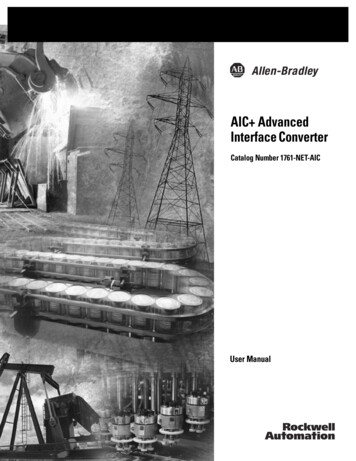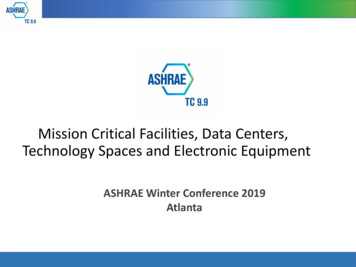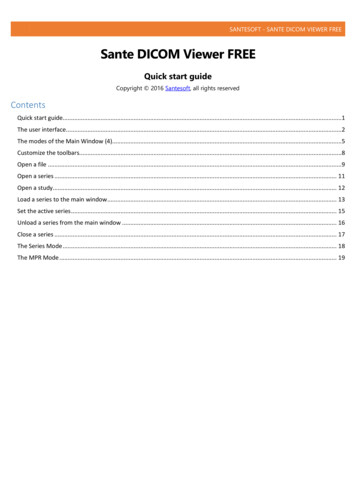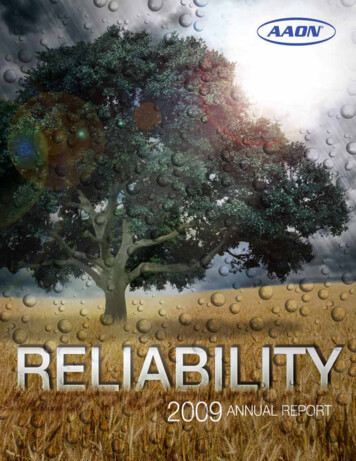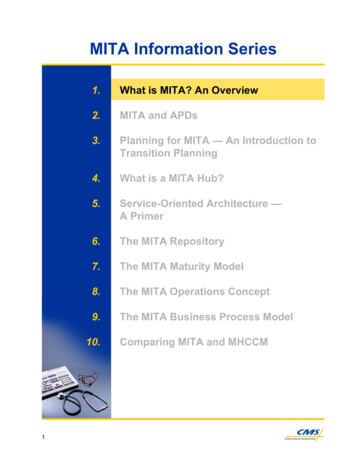
Transcription
MITA Information Series1.What is MITA? An Overview2.MITA and APDs3.Planning for MITA — An Introduction toTransition Planning4.What is a MITA Hub?5.Service-Oriented Architecture —A Primer6.The MITA Repository7.The MITA Maturity Model8.The MITA Operations Concept9.The MITA Business Process Model10.1Comparing MITA and MHCCM
What is MITA? An OverviewThis synopsis of the Medicaid Information Technology Architecture (MITA) is the first in a seriesof informative briefs describing the technical and programmatic aspects of the MITA program.OverviewMITA FrameworkApproachThe Medicaid Information Technology Architecture (MITA) is aninitiative of the Center for Medicaid & State Operations (CMSO), and itis aligned with the National Health Infrastructure Initiative (NHII)(http://aspe.hhs.gov/sp/nhii/).NHII is a voluntary network comprisingclinical, public health and personal health knowledge-basedinformation systems that make health information available as neededto improve decision-making. MITA is intended to foster integratedbusiness and IT transformation across the Medicaid enterprise toimprove the administration of the Medicaid program. Its commonbusiness and technology vision for state Medicaid organizations willemphasize:¾ A patient-centric view not constrained by organizational barriers¾ Common standards with, but not limited to, Medicare¾ Interoperability between state Medicaid organizations within andacross states, as well as with other agencies involved inhealthcare¾ Web-based access andintegration¾ Software reusabilityPRGMITAFRAMEWORKLOOGRNO¾ Integrationof publichealthdataCHAMSTE¾ Use of commercialoff-the-shelf(COTS)softwareYVISION2
What is MITA? An OverviewMedicaid MissionProvide quality health care to members by providing access to timely andcost-effective servicesMedicaid GoalsImprove health care outcomes for Medicaid beneficiaries and ensureefficient, effective, and economical management of the Medicaid programMITA MissionEstablish a nationalframework of enablingtechnologies and processesthat support improved programadministration for the Medicaid enterpriseand stakeholders dedicated to improvinghealthcare outcomes and administrativeprocedures for Medicaid beneficiariesMITA Goals¾ Develop seamless and integrated systemsthat effectively communicate, achievingcommon Medicaid goals throughinteroperability and standards¾ Promote an environment that supportsflexibility, adaptability, and rapid responseto changes in programs and technology¾ Promote an enterprise view that supportsenabling technologies aligned withMedicaid business processes andtechnologies¾ Provide data that is timely, accurate,usable, and easily accessible to supportanalysis and decision making for healthcare management and programadministration¾ Provide performance measurement foraccountability and planning¾ Coordinate with Public Health and otherpartners and integrate health outcomeswithin the Medicaid community3MITA Objectives¾ Adopt data and industry standards¾ Promote secure data exchange¾ Promote reusable components throughmodularity¾ Promote efficient and effective data sharing tomeet stakeholders’ needs¾ Provide a beneficiary-centric focus¾ Support interoperability and integration usingopen architecture standards¾ Promote good programmatic practices, such asthe use of the Software Engineering Institute’sCapability Maturity Model (SEI CMM), as welltechnical practices such as the use of a datawarehouse to separate on line analyticalprocessing (OLAP) from on line transactionprocessing (OLTP)¾ Support the integration of clinical andadministrative data to enable better decisionmaking¾ Break down artificial boundaries betweensystems, geography, and funding (with the TitleXIX program)
What is MITA? An ngMITA is intended to foster integrated business and IT transformationacross the Medicaid enterprise. It will establish national guidelines fortechnologies and processes that can enable improved programadministration for the Medicaid enterprise. Medicaid communities wantto ensure that the mission and goals of the Medicaid program are met.The MITA initiative includes an architecture framework, processes,and planning guidelines for enabling state Medicaid enterprises tomeet common objectives within the framework while supporting uniquelocal needs.¾ The MITA architecture framework is a consolidation of principles,business and technical models, and guidelines that combine toform a template for the states to use to develop their ownenterprise architectures.¾ MITA processes provide guidance for state Medicaid enterprises touse in adopting the MITA framework through shared leadership,partnering, and reuse of solutions.¾ MITA planning guidelines help states to define their own strategicMITA goals and objectives and to develop tailored enterprisearchitectures that are fully consistent with the CMSO expectations.In the future, these guidelines will serve as the basis for states’requests for appropriate Federal Financial Participation (FFP) fortheir Medicaid Management Information Systems (MMIS).The MITA journey is just beginning. This initial version of the MITAframework will evolve and grow with the participation and help ofMedicaid stakeholders and partners.4
What is MITA? An OverviewMITAChallengesMedicaid programs have become highly complex, multibillion-dollarenterprises in most states. They are major economic engines ―collectively drawing more than 180 billion in federal funding eachyear to local economies. Medicaid is typically the largest or secondlargest budget item in each state and has gained enormous politicalvisibility. The MMIS contract is typically the largest services contract letby state government and, in many cases, has also attracted intensepublic scrutiny.Historically, MMIS was designed primarily as a financial andaccounting system for paying provider claims accurately and timely.Yet, as the Medicaid program has grown more complex, the MMISsystems needed to support the Medicaid enterprise have also grown innumber and complexity. MMIS ― once defined as a single, integratedsystem of claims processing and information retrieval ― is beingredefined under MITA as the new "virtual MMIS" to most, if not all, ofthe additional non-financial Medicaid systems running on multiplehardware and software platforms.When Medicaid functions (such as managed care, clinical support,data analysis, fraud management, non-emergency transportationcoordination, prior authorization, etc.) were automated, they usuallywere added as separate systems cobbled together with the MMIS or,in some cases, hard-coded into the MMIS. As a result, these systemscould not communicate directly and exchanged information withdifficulty, often losing information. It usually was not possible forMedicaid administrators to obtain an hourly consolidated overview ofall provider and recipient activity because of this fragmentation (e.g., aprior authorization authorizer might not be able to see all outstandingauthorization requests, including dental, pharmacy, hospital, DME, andphysician, to understand an individual’s total program involvement).These special purpose "best-of-breed" systems might require up to adozen different servers and user support systems (e.g., separateapplications and call centers for provider services, recipient services,enrollment broker, pharmacy benefit management clinical help desksuppot, data warehouse support, desktop support, non-emergencytransportation (NET) support, fraud hot line, prior authorizationsupport, etc.). Each separate platform might have its own unique andusually proprietary architecture, data standards, update cycles, andwork flow requirements.There are situations where a state's MMIS might process most claimtypes under one architecture and one data standard, but other claimstypes (such as dental and pharmacy) might be processed throughstand-alone systems, each with its own architecture and datastandards. Formats for names, addresses, dates, and code sets for5
What is MITA? An Overviewgender, location, provider, and recipient might be stored three differentways and have three different meanings just in the three separateclaims processing systems (e.g., gender code might be 1, 2, or 3 inone system and M, F, or U in another). Translating these to onestandard for users and then merging all the data into the datawarehouse for MARS and SUR reporting, profiling and trend analysis,and pattern recognition can be very difficult; and severe compromisescan occur in data comparability and usability.MITA is intended to help the MMIS become the “central informationnervous system,” supporting the entire Medicaid Enterprise in astandard way. A universal data dictionary and standard definitions ofcommon data elements will help MMIS transcend platforms. Using"best of breed" systems for special purposes requires that theseindividual systems be compatible with the MMIS's data andarchitecture standards so they can communicate directly with eachother and the resulting processed data will be meaningful whenmerged into operational data stores.How WillMITA beUsed?CMS will use MITA as a tool for communicating a common vision forthe Medicaid program and for providing guidance on achieving thatvision. CMS will use an updated advance planning document (APD)review process and criteria to ensure that state IT planning meetsMITA goals and objectives. Details about the new review criteria willbe developed by interacting with the first states to adopt MITA.Examples of possible additions to the APD are to:¾ Demonstrate that planned enhancements support state andMedicaid strategic goals¾ Describe how intra-state systems other than the MMIS have beenconsidered in developing the solution¾ Document their analysis of alternative solutions—particularly areview of solutions implemented in other states that might beconsidered valuable¾ Describe data sharing components of the solution or justifyreasons for not including data sharing solutions at this time¾ Justify maintenance costs that exceed certain thresholds vs. costof enhancements that could reduce maintenance costs6
What is MITA? An OverviewStatesMITA will change the way states design and build, change, or modifytheir Medicaid systems and the manner in which states perform ITinvestment planning. In the future, states will need to ensure that theirbusiness goals and objectives meet the MITA goals and objectives. Toimplement the MITA framework, states will choose the elements of theMITA framework that best meet their strategic and tactical IT goals andobjectives, and their choices should be reflected in their APDs. CMSrecognizes that different states have differing needs and are likely tobegin their participation at different points. The MITA framework canaccommodate an implementation path best suited to each state’sindividual situation.To ensure that MITA meets the ongoing changing needs of the stateMedicaid participants, states can help refine the MITA frameworkmodels. States may collaborate on joint projects to develop andimplement shareable, reusable IT components and businessprocesses. State participation will help shape the Medicaid systems ofthe future.VendorsMITABenefits toStakeholdersPublicVendors will use MITA to shape their product offerings to enableservices to be leveraged and reused across states.MITA will provide significant benefits to Medicaid stakeholders,including the benefits to the public, states, and federal government.Greater beneficiary access to quality care. MITAcan enable the management of Medicaid programsto identify and target at-risk populations and to collectand publish point-of-care quality statistics for improvedpatient safety.Greater choice and independence forbeneficiaries.Improved state-to-state or intra-state analysis ofprovider performance can lead to better quality careand increased knowledge to promote choice andindependence for beneficiaries.Improved public health outcomes. MITA provides greater access toboth clinical and administrative data to support research, improvepublic health surveillance and alerting, and permit early detection ofand response to bio-terrorism attacks.7
What is MITA? An OverviewStatesImprovements in the management of the Medicaid program.States will have better access to a wider range of accurate and timelydata. A state can share this data within itself, with other states, andwith federal agencies through efficient and secure data exchange.State Medicaid systems will have greater adaptability and flexibility torespond to changes in legislation, court orders, and policies and will beable to support broader analysis of program needs and measurementof health outcomes.Improved return on state IT investment. The MITA frameworkprovides a common direction for the future development and evolutionof state MMIS. This common direction will result in a better return on ITinvestment through reusable system components, adherence tocommon standards, and improved coordination and alignment withnational health initiatives.IT alignment with Medicaid priorities. MITA promotes the alignmentof each state’s individual business goals with its IT strategies throughenterprise architecture. This approach will also allow bettercoordination with the state’s enterprise architecture.FederalGovernmentImproved CMS review of state Medicaid IT plans and systems.The MITA framework establishes criteria for guiding states’ APDdevelopment, including the components that reflect MITA goals andobjectives. CMS Regional Office staff will use the same criteria for aconsistent review of states’ APD submissions.Improved strategic planning and policy formulation. The MITAframework fosters sharing of timely, accurate, usable, easilyaccessible, and secure information among states and federalagencies, and it provides the necessary insights into the nationaltrends and needs of the Medicaid-eligible and -provider populations.Alignment with national health information initiatives. The MITAframework supports and incorporates the principles of nationalinitiatives, especially those that support improving public health dataquality.8
What is MITA? An OverviewMITA’sGuidingPrinciplesMITA represents a business-driven enterprise transformation.MITA is firmly grounded in enterprise architecture principles; MITAdefines a business transformation over a 5-year and long-term (10years and greater) timeframe, and defines a technical architecture anda transition strategy to enable the business transformation. Thisapproach, which is common today across industries as diverse asfinancial, transportation, and defense, will enable states to align ITsolutions with their common and unique business needs.MITA will support the following categories of business needs facingstate Medicaid organizations:¾ State needs3 Align with the state’s strategic goals3 Align with the state’s enterprise architecture¾ Medicaid-wide goals3 Align state approaches among states3 Align state approaches with national direction¾ National goals through MITA alignment with national initiatives andinternational standardsCommonality and differences co-exist. The MITA architecturedefines processes, data, and technical solutions that are common tomany state Medicaids with the provision for adapting and extendingthem to meet state-specific needs. Identifying common businessprocesses enables the definition and reuse of common solutions,making it possible for states to share development costs. The structureof the MITA models and templates capture and represent thesedifferences and accommodate cost-effective implementation of statespecific needs by using common solutions.States will participate in the development of the MITA models andtemplates, allowing for commonality and difference to be appropriatelyrepresented. They will agree on suitable common approaches, such asthe need to share data, develop end-to-end processes that connectorganizations, and reuse or repurpose technical solutions. They willagree to differ where appropriate, such as in supporting state-specificneeds or in promoting creativity and innovation. States will beencouraged to collaborate to create technical solutions that supportvariations, such as adapting or extending solutions. For example, thereshould be one set of data validity edits and one set of business rulesfor processing transactions used by multiple input sources (e.g., POS,Internet, direct data entry, key entry, EMC, etc.). All business rules andadjudication logic should be easy to modify or extend through the useof mechanisms like table-driven design or business rules engines.9
What is MITA? An OverviewThis approach seeks to achieve a balance between commonality anddifferences that enables standard mechanisms for interoperability anddata exchange. The goal is to maximize the benefit across theMedicaid enterprise, while promoting innovation and creativity in localimplementations.Emphasis on standards. MITA will promote the use of data andtechnical standards to improve the cost-effectiveness of ITdevelopment. The use of data standards provides better access todata by promoting data consistency and enhanced sharing throughcommon data access mechanisms. Adherence to technical standards,specifically open standards, facilitates integration of COTS solutionsand the reuse of solutions within and among states, resulting in lowerdevelopment costs and risks.To the greatest extent possible, MITA will rely on both nationalstandards for health and data exchange and open standards fortechnical solutions. Where Medicaid-specific standards are needed,MITA will foster agreement within the Medicaid community and, ifappropriate, submit standards to national standards bodies.Some specific opportunities for applying standards in the MITAarchitecture include:¾ All functional modules should be designed for component reuseand interoperability. A module from one vendor should bereplaced easily by an equivalent functional module from anothervendor (e.g., the data warehouse module from Vendor A can beeasily replaced by the data warehouse module from Vendor B).¾ All systems should use open, non-proprietary file structures thatcan be accessed by any other MMIS module or reporting system.¾ There should be one universal data directory with clear,unambiguous definitions and formats for each data element (e.g.,names, addresses, dates, and special code sets for sex, location,eligibility category, patient status, and procedure/diagnosis code).¾ All data structures and system architecture should be based onrelational database management system (RDBMS) design andopen n-tier architecture standards.¾ To the extent possible, multiple databases with similar data fromdifferent sources that feed the MMIS should be standardized andconcatenated into master records (e.g., multiple sources ofeligibility information should be consolidated around a single,permanent identification number in an eligibility hub). The same istrue for multiple sources of accounts receivables (adjustments,TPL recoveries, SUR recoveries, drug rebates, etc.).10
What is MITA? An OverviewBuilt-in security and privacy: Key security and privacy principlesinclude:¾ Security and privacy capabilities are defined and woventhroughout the architecture. Access requirements are identified inthe business processes, defined within the data models, andimplemented through the MITA technical models.¾ The MITA architecture provides the capabilities to protect theMedicaid enterprise against known threats and, through evolutionof the MITA architecture, readiness to respond to new threats.¾ Security is defined in the data models:– Access rights specified by role and by data element.– Tagging of private data.– Linking of use of data with data query definition.¾ Security is implemented in models using:– Configuration tools.– Business application functionality linked to common securitymechanisms.¾ A single security sign-on to all systems supporting the Medicaidenterprise.Data consistency throughout the enterprise: MITA will ensure, tothe maximum extent possible, that the number of copies of a dataelement is minimized; and multiple copies, if they must exist, aresynchronized in a timely manner; and that the official data of record isalways available. For example, it is recognized that OLAP requires adifferent database organization and architecture than continuousOLTP, and it may be desirable to have different hardware/softwareplatforms and data stores for the claims and transaction processingengine and the data warehouse.The data warehouse should always balance with and be synchronizedwith the transaction processing engines that feed it. For example,actual dollars claimed by a state on MARS reports should balance withfunds actually paid out by claims processing.11
What is MITA? An OverviewMITA Artifactsand TheirRelationshipsThe Key MITA artifacts are:¾ Architecture Framework¾ Processes¾ GuidelinesKey MITA rIndiviualeFrameworkProcessesStates¾ Transition and implementationplanning¾ Business architecture¾ Technical architecture¾ Cross-cutting architecture¾ Advance planning document(APD) process¾ Shared responsibility andcommitment¾ Management of working groupsGuidelines¾ IT portfolio management¾ State Medicaid enterprisearchitecture development¾ MITA solution sets¾ Transition strategy¾ Change managementArchitectureFrameworkThe MITA architecture framework comprises three sets of artifacts:¾ Business architecture¾ Technical architecture¾ Cross-cutting architectureBusinessTechnicalCross-CuttingBusiness ArchitectureThe MITA business architecture describes the current and futurebusiness operations of a state Medicaid organization. It includes anoperations concept, business process model, and businesscapabilities. The MITA business architecture enables a state to definea target business vision, business processes, and capabilities to usefor defining its target technical architecture.12
What is MITA? An OverviewTechnical ArchitectureThe MITA technical architecture includes a data architecture, anapplication architecture, and a technology architecture. Collectively,they define a set of technical services and standards that a state canuse to plan and specify its future systems.Cross-Cutting ArchitectureThe cross-cutting architecture includes services that span both thebusiness and technology architectures. Services in this categoryinclude flexibility, security, and privacy.ProcessesMITA processes provide structured approaches for a state to plan andimplement its transition to the MITA architecture. The initial set ofprocesses includes:¾ Transition and implementation planning¾ APD process¾ Shared responsibility and commitment¾ Managing working groups¾ Change managementTransition and implementation planning enables a state to define itstarget business architecture and capabilities and to develop a phasedplan to achieve the target state. The APD process describes the MITAbased approval criteria for APDs, and the approach for a state to usein developing its APDs.MITA implementation will require the collaborative efforts ofstakeholders. The shared responsibility and commitment processdefines the MITA governance structure and procedures necessary toachieve the needed stakeholder participation for the MITA program’ssuccess. A key aspect of MITA governance is the formation andconduct of working groups that enables states to collaborate onsolutions. The managing working groups process defines the structureof working groups and the process governing their operation. Finally,the change management process describes the organization structureand procedures for configuration management of MITA artifacts.13
What is MITA? An OverviewGuidelinesMITA guidelines provide a state with recommendations and bestpractices in support of implementing the MITA transition andimplementation planning process. The guidelines include:¾ IT portfolio management¾ State Medicaid enterprise architecture development¾ MITA solution sets¾ Transition strategyIT portfolio management provides each state with a recommendedapproach and criteria for evaluating its IT applications. State Medicaidenterprise architecture development describes a recommendedapproach for a state to develop its Medicaid enterprise architecture sothat it is consistent with MITA and the enterprise architecturedeveloped by the state CIO’s office. The transition strategy describesbest practices for migration from legacy business and technicalarchitectures to the MITA architecture.MITATechnicalArchitectureFeaturesThe following are the key features of the MITA technical architecture:¾ Service-oriented architecture¾ Common interoperability and access services¾ Adaptability and extensibility¾ Hub architecture¾ Performance measurementService-Oriented ArchitectureA service oriented architecture (SOA) is a software design strategy inwhich common functionality and capabilities (utility services) arepackaged with standard, well-defined “service interfaces” that providefunctionality that is formally described and can be invoked using apublished “service contract.” Users of utility services need not beaware of “what’s under the hood;” a utility service can be built usingnew applications, legacy applications, COTS software, or all three.Utility services will be designed so that they change to support statespecific implementations.(Note: The MITA term “utility services” represents the more commonlyused architectural term “services” inherent in an SOA. MITA uses theterm “utility services” to avoid confusing this technical concept with“Medicaid program services” or “services to beneficiaries.”).14
What is MITA? An OverviewCommon Interoperability and AccessUtility services make it possible to implement common interoperabilityand access. Interoperability refers to system-to-systemcommunication, and access refers to system-to-personcommunication. For example, personal digital assistant (PDA) accesscould be provided to multiple applications, or conversely, a singleapplication could allow access from multiple devices: Web interfaces,PDAs, kiosks, or voice response systems.Adaptability and ExtensibilityAdaptations allow a state to change the specifics of processes, data,or technical solutions using configuration files to meet its specificneeds. Extensions allow states to add new functionality andcapabilities. Both characteristics build in the capabilities needed toaccommodate both common needs as well as each state’s uniqueneeds.Hub ArchitectureThe hub architecture facilitates data exchange and data sharing whileallowing each organization control and ownership of its own data.Hubs, unlike data marts and data warehouses, do not require the datato be moved to a central location. Data will be described usingstandard definition formats that map the data to standard dataelements where appropriate, and provide the data descriptions whenthe data elements are non-standard. Security and privacy access rulesfor each data element will be represented in a standard way. Acollection of utility services at hubs will read the data descriptions andthe security and access rules and use that information to “expose” thedata to users who qualify for access and to receive and process theirqueries.Performance MeasurementThe use of standards and agreement on a set of common businessprocesses and data standards make it possible to developperformance metrics, measurement techniques, and correspondingutility services. Performance metrics make it possible to track changesin programs and policies and evaluate corresponding changes inhealth outcomes, measuring business performance across theMedicaid enterprise.15
What is MITA? An OverviewNext StepsToday’s MMIS has come a long way since its inception in the 1970s.We have been at work on MITA for little more than 2 years. While wedo not envision this development process lasting another 30 years, werealize that for MITA to achieve its ambitious goals, it will take time,hard work, and tremendous collaboration among Medicaidstakeholders, including the public sector, IT industry, providers, andbeneficiaries.Our approach will be to test products with our state partners as theybecome available in the field. We will incorporate creative solutions toadvance the goals of MITA. We will call attention to some successfulimplementations (e.g., early adopter states), which others may use asa model and for their “best practices.” As MITA evolves, we will use itsprinciples as key criteria for CMS officials to use in their review andapproval of federal financial participation (FFP) for the MMIS systemsof the future. We will incorporate these standards into the FederalMMIS Certification Review criteria as benchmarks to measureprogress from today’s transaction-based MMIS systems toenterprisewide, patient-centric MMIS systems.Finally, an important aspect of MITA’s development is for us at CMS tocontinually improve the effectiveness of our communication. We wouldgreatly appreciate your feedback on this paper. Did you find it useful?If not, why not? What can we do better in the future?For further information, please contact:Denise Bazemore, Technical DirectorDivision of State Systems, CMSOCenter for Medicare and Medicaid ServicesU.S. Department of Health and Human ServicesPhone: 410-786-4449dbazemore@cms.hhs.govThank you for your interest.16
Service-Oriented Architecture — A Primer 6. The MITA Repository 7. The MITA Maturity Model 8. The MITA Operations Concept 9. The MITA Business Process Model 10. Comparing MITA and MHCCM . What is MITA? An Overview This synopsis of the Medicaid Information Technology





